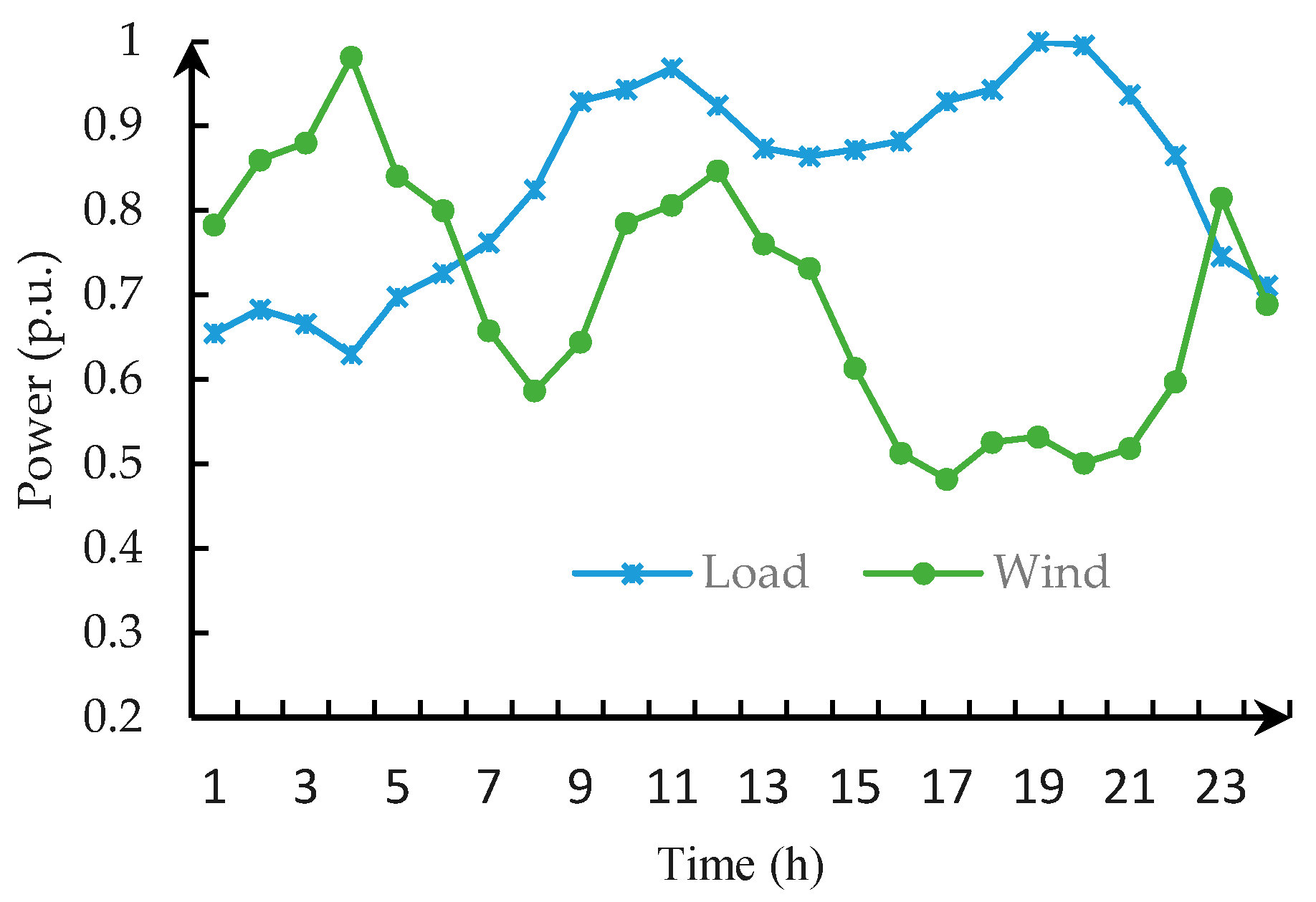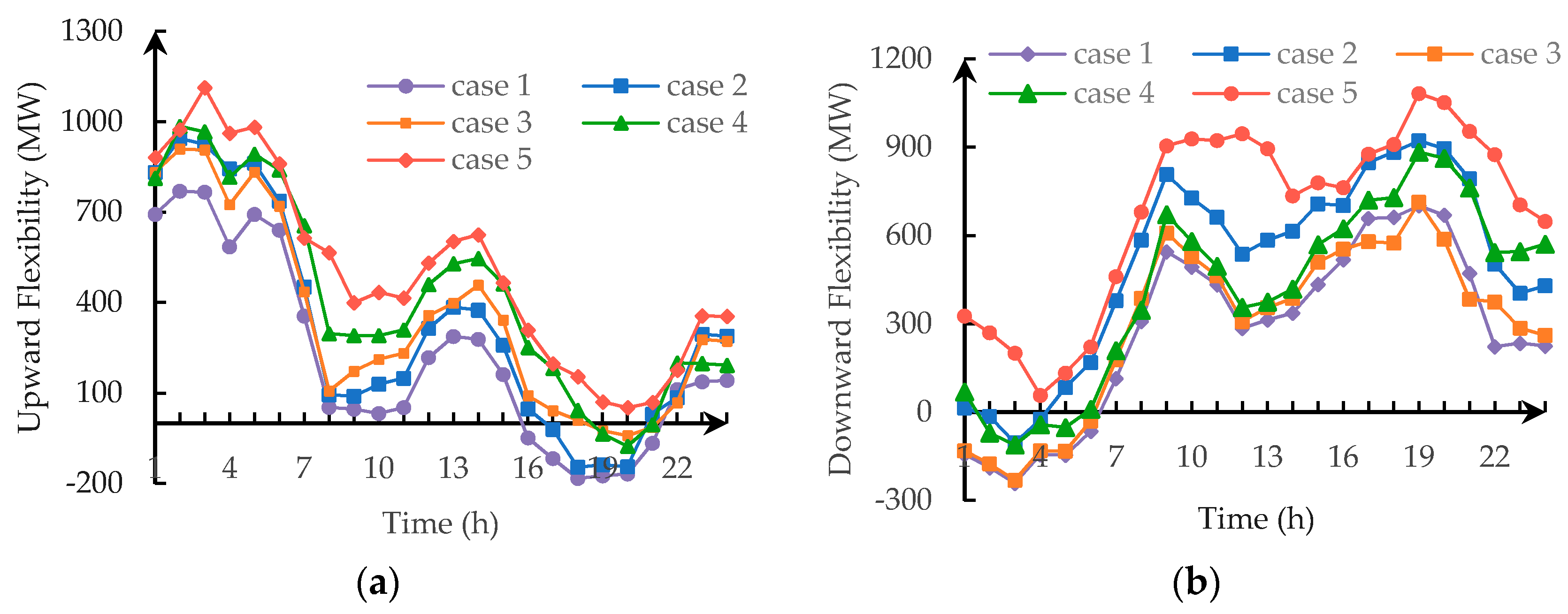Optimal Scheduling of a Multi-Energy Power System with Multiple Flexible Resources and Large-Scale Wind Power
Abstract
1. Introduction
- Considering the low load fatigue life loss and oil injection cost of the unit, a three-phase peaking cost model of thermal power generation was established;
- The flexibility margin index of power system containing the flexible resources of source-load-storage has been proposed, which can be employed to evaluate the adjustment potential of various flexible resources and the flexibility of system operation;
- With the objective of minimizing the total dispatching cost, an optimal power system dispatching model, which contains multi-flexible resources such as thermal power deep peak regulation, demand response, and energy storage, was established.
2. Three-Stage Peak Regulation Cost Model for Thermal Units
3. Flexibility Margin of Power System
3.1. Analysis of Flexibility Resource
3.1.1. Flexibility of Thermal Power Units
3.1.2. Flexibility of Demand Response
3.1.3. Flexibility of Energy Storage
3.2. Analysis of Flexibility Demand
3.3. Index of Flexibility Margin
4. Optimal Scheduling Model for Multi-Energy Power Systems with Multiple Flexible Resources and Large-Scale Wind Power
4.1. Objective Function
4.2. Constraints
4.3. Solution Methods
5. Case Study
5.1. Basic Data
5.2. Comparative Analysis of System Scheduling Results in Different Cases
- Case 1:
- The thermal units are in conventional peak regulation, and there is no other flexible resources.
- Case 2:
- Two 300 MW thermal units are in deep peak regulation and there is no other flexible resources.
- Case 3:
- With the demand response resources, the thermal units are in conventional peak regulation.
- Case 4:
- With energy storage resources, the thermal units are in conventional peak regulation.
- Case 5:
- Containing energy storage and demand response resources, two 300 MW thermal units are in deep peak regulation.
5.3. Sensitivity Analysis of Wind Power Capacity
6. Conclusions
Author Contributions
Funding
Conflicts of Interest
References
- Global Wind Energy Council. Global Wind Report 2017; Global Wind Energy Council: Brussels, Belgium, 2018. [Google Scholar]
- Heggarty, H.; Bourmaud, J.; Girard, R. Multi-temporal Assessment of Power System Flexibility Requirement. Appl. Energy 2019, 238, 1327–1336. [Google Scholar] [CrossRef]
- Lu, Z.X.; Li, H.B.; Qiao, Y. Flexibility Evaluation and Supply/Demand Balance Principle of Power System with High-penetration Renewable Electricity. Proc. CSEE 2017, 37, 9–20. [Google Scholar]
- Auer, H.; Haas, R. On integrating large shares of variable renewables into the electricity system. Energy 2016, 115, 1592–1601. [Google Scholar] [CrossRef]
- Lund, P.D.; Lindgren, J.; Mikkola, J. Review of energy system flexibility measures to enable high levels of variable renewable electricity. Renew. Sustain. Energy Rev. 2015, 45, 785–807. [Google Scholar] [CrossRef]
- Mathiesen, B.V.; Lund, H.; Connolly, D. Smart Energy Systems for coherent 100% renewable energy and transport solutions. Appl. Energy 2015, 145, 139–154. [Google Scholar] [CrossRef]
- Dui, X.; Zhu, G.; Yao, L. Two-Stage Optimization of Battery Energy Storage Capacity to Decrease Wind Power Curtailment in Grid-Connected Wind Farms. IEEE Trans. Power Syst. 2018, 33, 3296–3305. [Google Scholar] [CrossRef]
- Yang, T.M.; Lou, S.H.; Zhang, X.C. Coordinated optimal operation of hybrid energy storage in power system accommodated high penetration of wind power. In Proceedings of the 2015 5th International Conference on Electric Utility Deregulation and Restructuring and Power Technologies (DRPT), Changsha, China, 26–29 November 2015. [Google Scholar]
- Hajibandeh, N.; Shafie-khah, M.; Gerardo, J. A heuristic multi-objective multi-criteria demand response planning in a system with high penetration of wind power generators. Appl. Energy 2018, 212, 721–732. [Google Scholar] [CrossRef]
- Gao, J.W.; Ma, Z.Y.; Guo, F.J. The influence of demand response on wind-integrated power system considering participation of the demand side. Energy 2019, 178, 723–738. [Google Scholar] [CrossRef]
- Liu, X.C.; Wang, P.P.; Li, Y. Stochastic Unit Commitment Model for High Wind Power Integration Considering Demand Side Resources. Proc. CSEE 2015, 35, 3714–3723. [Google Scholar]
- Lin, L.; Tian, X.Y. Analysis of deep peak regulation and its benefit of thermal units in power system with large scale wind power integrated. Power Syst. Technol. 2017, 41, 2255–2263. [Google Scholar]
- Yang, Y.; Qin, C.; Zeng, Y. Interval Optimization-Based Unit Commitment for Deep Peak Regulation of Thermal Units. Energies 2019, 12, 922. [Google Scholar] [CrossRef]
- Deng, T.T.; Lou, S.H.; Tian, X. Optimal Dispatch of Power System Integrated with Wind Power Considering Demand Response and Deep Peak Regulation of Thermal Power Units. Autom. Electr. Power Syst. 2019, 43, 24–41. [Google Scholar]
- Tan, Z.F.; Ju, L.W.; Li, H.H. A two-stage scheduling optimization model and solution algorithm for wind power and energy storage system considering uncertainty and demand response. Int. J. Electr. Power Energy Syst. 2014, 63, 1057–1069. [Google Scholar] [CrossRef]
- Su, C.G.; Shen, J.J.; Wang, P.L.; Zhou, L.G.; Cheng, C.T. Multi-source coordinated scheduling method for wind power system based on power supply flexibility margin. Autom. Electr. Power Syst. 2018, 42, 111–122. [Google Scholar]
- Xie, T.; Lv, K.; Huang, J.S. Study on the thermodynamic characteristic of generalized regenerative system used for deep peak load regulating operation. Therm. Power Gener. 2018, 5, 71–76. [Google Scholar]
- Ma, J.; Silva, V.; Belhomme, R. Evaluating and Planning Flexibility in Sustainable Power Systems. IEEE Trans. Sustain. Energy 2013, 4, 200–209. [Google Scholar] [CrossRef]
- Lynch, M.; Nolan, S.; Devine, M.T. The impacts of demand response participation in capacity markets. Appl. Energy 2019, 250, 444–451. [Google Scholar] [CrossRef]
- Logenthiran, T.; Srinivasan, D.; Shun, T.Z. Demand Side Management in Smart Grid Using Heuristic Optimization. IEEE Trans Smart Grid 2012, 3, 1244–1252. [Google Scholar] [CrossRef]
- Lou, S.H.; Wu, Y.W.; Cui, Y.Z. A Battery Energy Storage Strategy for Short-Term Wind Power Power Fluctuation. Autom. Electr. Power Syst. 2014, 38, 17–22. [Google Scholar]
- Yang, Y.; Chen, Y.Y.; Zhang, W. Power Market Model Considering Distributed Generation and Incom-plete Information Interruptible Load Selection. Proc. CSEE 2011, 31, 15–24. [Google Scholar]
- Jian, X.H.; Zhang, L.; Miao, X.F. Designing Interruptible Load Management Scheme Based on Customer Performance Using Mechanism Design Theory. Electr. Power Energy Syst. 2018, 95, 476–489. [Google Scholar] [CrossRef]
- Zhang, N.; Kang, C.; Xia, Q. A Convex Model of Risk-Based Unit Commitment for Day-Ahead Market Clearing Considering Wind Power Uncertainty. IEEE Trans. Power Syst. 2014, 30, 1582–1592. [Google Scholar] [CrossRef]
- Grigg, C.; Wong, P.; Albrecht, P.; Allan, R.; Bhavaraju, M.; Billinton, R.; Chen, Q.; Fong, C.; Haddad, S.; Kuruganty, S.; et al. The IEEE reliability test system-1996. IEEE Trans. Power Syst. 1999, 14, 1010–1018. [Google Scholar] [CrossRef]
- Niu, W.J.; Li, Y.; Wang, W. Modeling of Demand Response Virtual Power Plant Considering Uncertainty. Proc. CSEE 2014, 34, 3630–3637. [Google Scholar]
- Lu, Z.G.; Guo, K.; Yan, G.H. Optimized Scheduling of Wind Power System Based on Demand Response for Virtual Machines and Carbon Trading. Autom. Electr. Power Syst. 2017, 41, 58–65. [Google Scholar]





| Parameters | Values |
|---|---|
| Capacity of energy storage (MWh) | 400 |
| Rated charging/discharging power (MW) | 100 |
| Charging and discharging efficiency | 90 |
| Capacity of each interruptible user (MW) | 60 |
| Number of interruptible users | 3 |
| Maximum interruptible time (h) | 6 |
| Minimum interruptible time (h) | 3 |
| Quadratic coefficient of compensation cost | 0.4 |
| First term coefficient of compensation cost | 25 |
| Cost | Case 1 | Case 2 | Case 3 | Case 4 | Case 5 |
|---|---|---|---|---|---|
| Total dispatching cost (104 $) | 287.5 | 259.7 | 260.6 | 258.1 | 233.7 |
| Fuel cost (104 $) | 248.5 | 235.9 | 238.7 | 225.4 | 217.2 |
| Start–stop costs (104 $) | 15.6 | 12.6 | 13.4 | 14.8 | 11.2 |
| Penalty cost for wind abandonment (104 $) | 13.8 | 2.4 | 6.4 | 12.6 | 0 |
| Penalty cost for loss of load (104 $) | 9.6 | 8.8 | 2.1 | 0 | 0 |
| Compensation for load interruption (104 $) | 0 | 0 | 0 | 5.3 | 5.3 |
| Cost for peak regulation (104 $) | 0 | 4.4 | 0 | 0 | 2.3 |
| Cost | 400 (MW) | 600 (MW) | 800 (MW) | 1000 (MW) | 1200 (MW) |
|---|---|---|---|---|---|
| Total dispatching cost (104 $) | 261.8 | 248.2 | 233.7 | 223.6 | 227.0 |
| Fuel cost (104 $) | 247.5 | 232.3 | 217.2 | 203.7 | 195.1 |
| Start–stop costs (104 $) | 9.8 | 10.6 | 11.2 | 12.2 | 13.6 |
| Penalty cost for wind abandonment (104 $) | 0 | 0 | 0 | 2.4 | 9.8 |
| Penalty cost for loss of load (104 $) | 0 | 0 | 0 | 0 | 3.2 |
| Compensation for load interruption (104 $) | 4.5 | 5.3 | 5.3 | 5.3 | 5.3 |
| Cost for peak regulation (104 $) | 0.6 | 1.7 | 2.3 | 3.8 | 5.6 |
© 2019 by the authors. Licensee MDPI, Basel, Switzerland. This article is an open access article distributed under the terms and conditions of the Creative Commons Attribution (CC BY) license (http://creativecommons.org/licenses/by/4.0/).
Share and Cite
Che, Q.; Lou, S.; Wu, Y.; Zhang, X.; Wang, X. Optimal Scheduling of a Multi-Energy Power System with Multiple Flexible Resources and Large-Scale Wind Power. Energies 2019, 12, 3566. https://doi.org/10.3390/en12183566
Che Q, Lou S, Wu Y, Zhang X, Wang X. Optimal Scheduling of a Multi-Energy Power System with Multiple Flexible Resources and Large-Scale Wind Power. Energies. 2019; 12(18):3566. https://doi.org/10.3390/en12183566
Chicago/Turabian StyleChe, Quanhui, Suhua Lou, Yaowu Wu, Xiangcheng Zhang, and Xuebin Wang. 2019. "Optimal Scheduling of a Multi-Energy Power System with Multiple Flexible Resources and Large-Scale Wind Power" Energies 12, no. 18: 3566. https://doi.org/10.3390/en12183566
APA StyleChe, Q., Lou, S., Wu, Y., Zhang, X., & Wang, X. (2019). Optimal Scheduling of a Multi-Energy Power System with Multiple Flexible Resources and Large-Scale Wind Power. Energies, 12(18), 3566. https://doi.org/10.3390/en12183566






